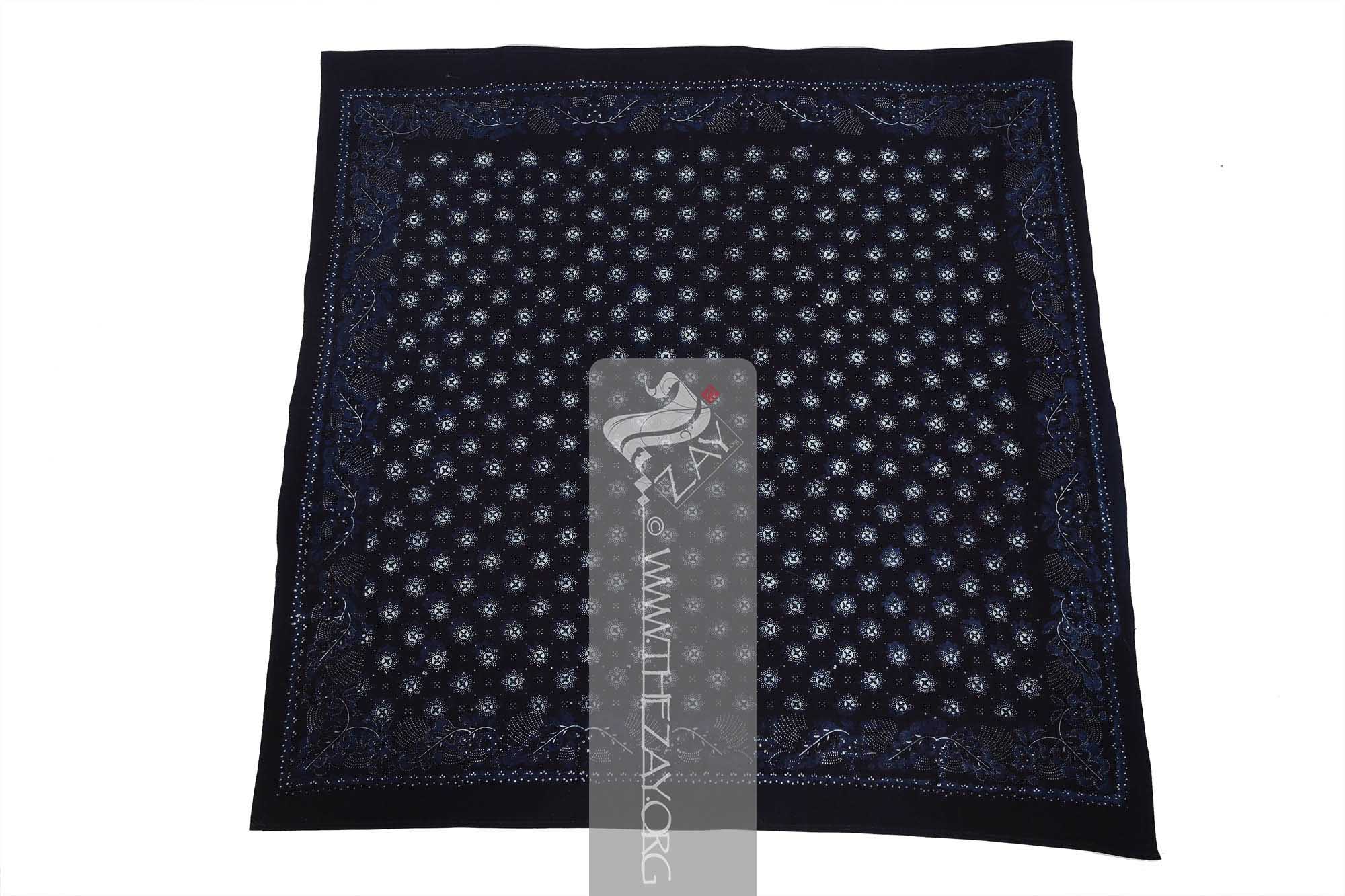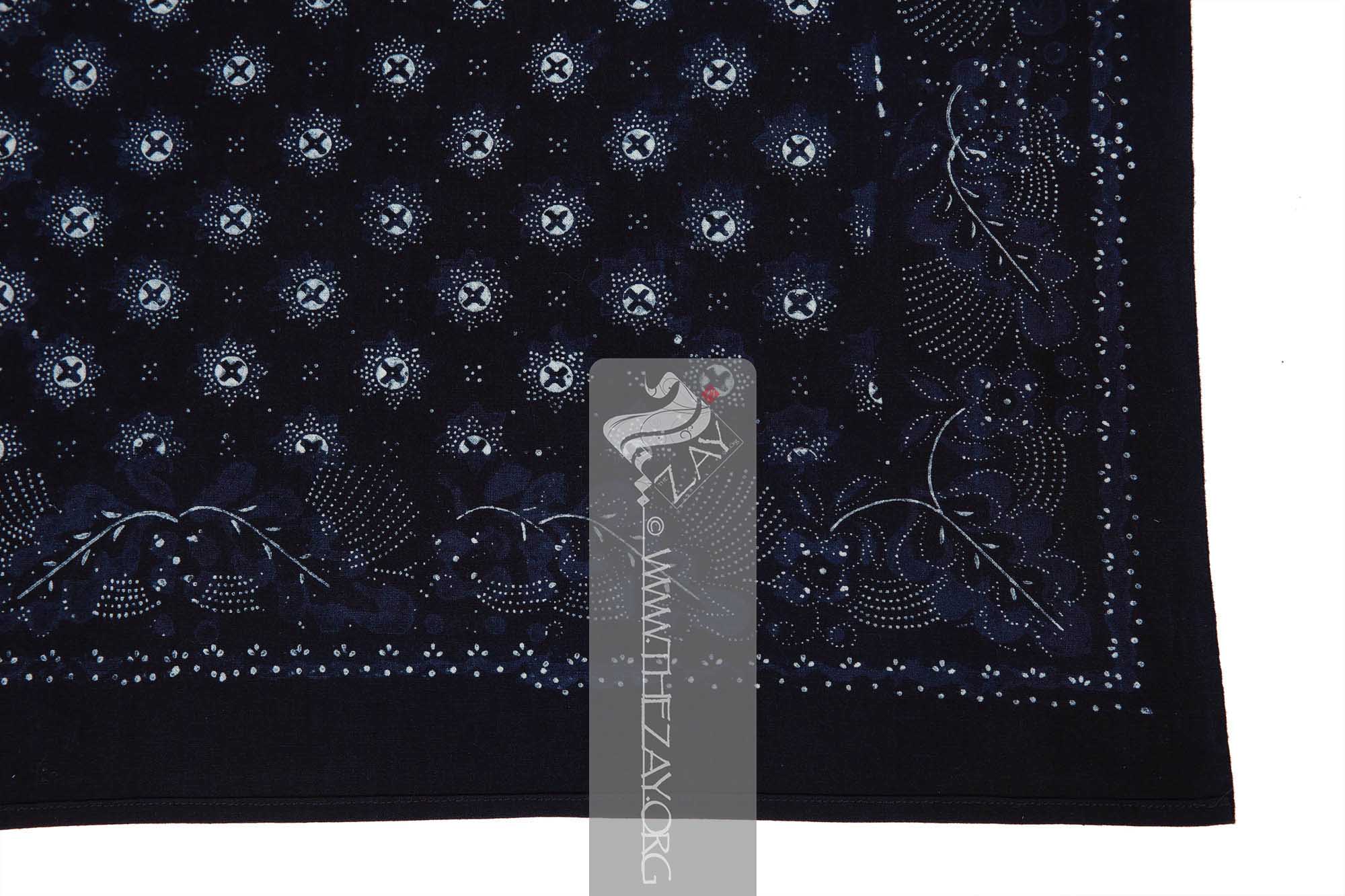Object History This cotton-printed rectangular fabric was gifted to Dr. Reem Tariq
Ṭariq: (Arabic; Synonym: tulle_bi_talli
Tūlle_bi_tallī: (French: Tulle – a city in France where fine material for veil was first made; Turkish: tel – wire; Synonym: tariq; talli; badla; khus_dozi ), series of small metal knots made on a woven net ground as embellishment. The term is commonly used in the North African Arab region specifically in Egypt.
; talli; badla; khus_dozi ), series of small metal knots made on a woven net ground as embellishment. The term is commonly used in the Levant Arab region specifically in Lebanon.
El Mutwalli
Dr. Reem Tariq
Ṭariq: (Arabic; Synonym: tulle_bi_talli
Tūlle_bi_tallī: (French: Tulle – a city in France where fine material for veil was first made; Turkish: tel – wire; Synonym: tariq; talli; badla; khus_dozi ), series of small metal knots made on a woven net ground as embellishment. The term is commonly used in the North African Arab region specifically in Egypt.
; talli; badla; khus_dozi ), series of small metal knots made on a woven net ground as embellishment. The term is commonly used in the Levant Arab region specifically in Lebanon.
el Mutwallī: Founder (CEO) of the Zay
Zay: (Arabic: costume, Pl. azyaā’), a set of clothes in a style typical of a particular country or historical period. Initiative, a public figure, speaker and author. An expert curator and consultant in Islamic art and architecture, interior design, historic costume, and UAE heritage. by Ms. Manami Tominaga, a Japanese lady living in the UAE, in 2017. It was eventually added to The Zay
Zay: (Arabic: costume, Pl. azyaā’), a set of clothes in a style typical of a particular country or historical period. Initiative collection. Object Features This is a cotton fabric with floral motifs in (indigo
Indigo: (Latin: Indigo – India, synonym: nil
Nīl: (Latin: indigo), Arabised term for Indigo, a natural dye belonging to the ‘Indigofera Tinctoria’ species of plants that have been cultivated in East Asia, Egypt, India, and Peru since antiquity. According to Pliny the Elder, it was named after India as it was the source of the dye.), a natural dye belonging to the ‘Indigofera Tinctoria’ species of plants that has been cultivated in East Asia, Egypt, India, and Peru since antiquity. According to Pliny the Elder, it was named after India as it was the source of the dye. ) blue stencil printing or (katazome_print
Katazome_print: A traditional Japanese resist printing technique where a stencil is used to apply a rice paste resist onto fabric before dyeing, creating intricate and precise patterns. First developed as a substitute to expensive and time-consuming woven brocade it became a well-respected fabric art over time. ) technique. It has a thick border in two tiers. The first tier or the outermost layer is filled with dotted repeats and the second tier, or the inner layer is a floral repeat with dots and wavy lines. The main field of the fabric is filled with repeats of a dotted floral motif.
More infoKatazome is a traditional Japanese textile printing technique that utilizes stencils to create intricate and detailed designs on fabric. The word "katazome" translates to "stencil dyeing" in English, and the technique involves creating a stencil out of paper or other materials and then applying a resist paste to the fabric through the stencil. Once the paste has dried, the fabric is dyed, and the areas where the resist paste was applied remain undyed, creating a pattern on the fabric. Katazome stencils are typically made using a combination of hand-carving and off-late machine-cutting techniques. The stencils themselves can be highly detailed, with intricate designs and patterns that can take weeks or even months to create. The resist paste used in katazome can also vary depending on the desired effect, with some pastes being more resistant to dye than others. During the Edo period (1603-1868), katazome became a popular art form among the common people in Japan, and various regional styles of the technique emerged. In addition to clothing, katazome was used to create a wide range of household items such as curtains, bedding, and tablecloths. The intricate designs and vibrant colours of katazome made it a highly sought-after craft, and the popularity of the technique continued to grow. Links
- Morishima, Yuki, et al. Kimono
Kimono: (Japanese: ki : wearing, mono: thing, Singular: Kimono) A traditional Japanese long loose robe with wide sleeves tied with a sash around the waist. Presently it is the national dress of Japan. Refashioned: Japan’s Impact on International Fashion. USA, Asian Art Museum, 2018.
- Kahlenberg, Mary Hunt. Asian Costumes and Textiles: From the Bosphorus to Fujiama. Italy, Skira, 2001.
- Liddell, Jill. The Story of the Kimono
Kimono: (Japanese: ki : wearing, mono: thing, Singular: Kimono) A traditional Japanese long loose robe with wide sleeves tied with a sash around the waist. Presently it is the national dress of Japan. . USA, E P Dutton, 1989.
- Dalby, Liza Crihfield. Kimono
Kimono: (Japanese: ki : wearing, mono: thing, Singular: Kimono) A traditional Japanese long loose robe with wide sleeves tied with a sash around the waist. Presently it is the national dress of Japan. : Fashioning Culture. Reaktion Books, 1993.
- Gluckman, Dale Carolyn and Sharon Sadako Takeda. When Art Became Fashion: Kosode
Kosode: (Japanese: small sleeve or opening), a traditional Japanese inner robe for both genders. Similar to a kimono but with a wider body, longer collars, and narrower and rounded sleeves, often stitched to the body, these under robes were lavishly decorated and were worn on top from late 16th century. in Edo-Period Japan. Los Angeles County Museum of Art, 1996.
- Kimono
Kimono: (Japanese: ki : wearing, mono: thing, Singular: Kimono) A traditional Japanese long loose robe with wide sleeves tied with a sash around the waist. Presently it is the national dress of Japan. : Kyoto to Catwalk. 27 Aug. – 25 Oct. 2020, V&A South Kensington, London https://www.vam.ac.uk/exhibitions/kimono
Kimono: (Japanese: ki : wearing, mono: thing, Singular: Kimono) A traditional Japanese long loose robe with wide sleeves tied with a sash around the waist. Presently it is the national dress of Japan. -kyoto-to-catwalk
- Gluckman, Dale Carolyn. “Liza Dalby. Kimono
Kimono: (Japanese: ki : wearing, mono: thing, Singular: Kimono) A traditional Japanese long loose robe with wide sleeves tied with a sash around the waist. Presently it is the national dress of Japan. : Fashioning Culture.:Kimono
Kimono: (Japanese: ki : wearing, mono: thing, Singular: Kimono) A traditional Japanese long loose robe with wide sleeves tied with a sash around the waist. Presently it is the national dress of Japan. : Fashioning Culture.” Museum Anthropology, vol. 19, no. 1, Mar. 1995, pp. 79–81. Crossref, https://doi.org/10.1525/mua.1995.19.1.79
- “Meisen Kimono
Kimono: (Japanese: ki : wearing, mono: thing, Singular: Kimono) A traditional Japanese long loose robe with wide sleeves tied with a sash around the waist. Presently it is the national dress of Japan. From HALI 184 - HALI.” HALI, 24 July 2015, hali.com/news/meisen-kimono
Kimono: (Japanese: ki : wearing, mono: thing, Singular: Kimono) A traditional Japanese long loose robe with wide sleeves tied with a sash around the waist. Presently it is the national dress of Japan. .
- Kimono
Kimono: (Japanese: ki : wearing, mono: thing, Singular: Kimono) A traditional Japanese long loose robe with wide sleeves tied with a sash around the waist. Presently it is the national dress of Japan. Style: Edo Traditions to Modern Design: The John C. Weber Collection. USA, Met Publications, www.metmuseum.org/art/metpublications/Kimono_Style
- Richard, Naomi Noble. “Nō Motifs in the Decoration of a Mid-Edo Period Kosode
Kosode: (Japanese: small sleeve or opening), a traditional Japanese inner robe for both genders. Similar to a kimono but with a wider body, longer collars, and narrower and rounded sleeves, often stitched to the body, these under robes were lavishly decorated and were worn on top from late 16th century. .” Metropolitan Museum Journal, vol. 25, 1990, pp. 175–83. JSTOR, https://doi.org/10.2307/1512899. Accessed 10 May 2023.
- Kramer, Elizabeth. “Review of ‘Kimono
Kimono: (Japanese: ki : wearing, mono: thing, Singular: Kimono) A traditional Japanese long loose robe with wide sleeves tied with a sash around the waist. Presently it is the national dress of Japan. : A Modern History.’” Reviews in History, School of Advanced Study, 2015. Crossref, https://doi.org/10.14296/rih/2014/1787.
- https://www.rochestertextile.com/post/398841446836/japanese-crepe
Crepe: (Latin: crispus; Old French: crespe – curled or frizzed), is a lightweight, crinkled fabric with a pebbled texture woven from a hand spun untreated or ‘in the gum’ silk yarn.
-fabrics-chirimen
chirimen: A Japanese crepe
Crepe: (Latin: crispus; Old French: crespe – curled or frizzed), is a lightweight, crinkled fabric with a pebbled texture woven from a hand spun untreated or ‘in the gum’ silk yarn.
fabric traditionally made from silk. It has a distinctive pebbly texture and is commonly used in kimono
Kimono: (Japanese: ki : wearing, mono: thing, Singular: Kimono) A traditional Japanese long loose robe with wide sleeves tied with a sash around the waist. Presently it is the national dress of Japan. and other traditional garments. Originally brought from China chirimen weaving extensively developed during the Edo period (1603-1868) and continues to be a popular textile in modern Japan. -kinsha
- https://www.kyoto-museums.jp/en/museum/east/3754/
- https://www.kitchenstudiofactory.com/critical-craft-biography/rags-to-riches-kosode
Kosode: (Japanese: small sleeve or opening), a traditional Japanese inner robe for both genders. Similar to a kimono but with a wider body, longer collars, and narrower and rounded sleeves, often stitched to the body, these under robes were lavishly decorated and were worn on top from late 16th century. -to-kimono
Kimono: (Japanese: ki : wearing, mono: thing, Singular: Kimono) A traditional Japanese long loose robe with wide sleeves tied with a sash around the waist. Presently it is the national dress of Japan.





